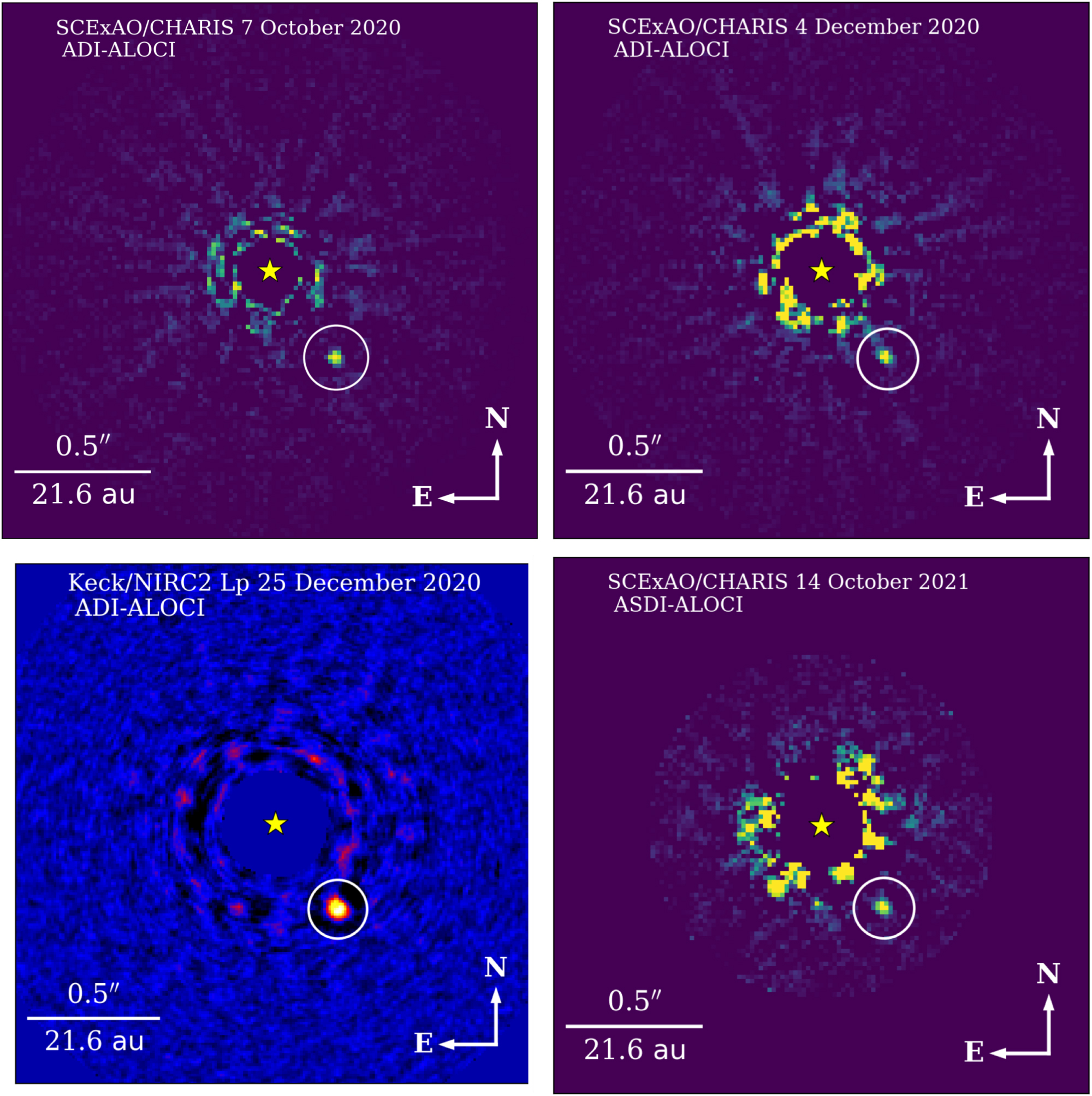Maunakea, Hawaiʻi – A team of astronomers using two Maunakea Observatories in Hawaiʻi – W. M. Keck Observatory and Subaru Telescope – have photographed a brown dwarf orbiting HIP 21152, a young Sun-like star in the Hyades Cluster.
Located just 150 light-years away, Hyades is the closest star cluster to Earth in the constellation Taurus; its v-shaped pattern can be seen with the unaided eye. Because this group of young stars were born at almost the same time, the Hyades Cluster has attracted astronomers’ attention as an important research target for studying the evolution of stars and planets.
The newly-found brown dwarf in this cluster, called HIP 21152 B, is the first confirmed substellar companion of a main sequence star in Hyades discovered via direct imaging. Its mass is similar to a giant planet – between 22-36 Jupiter masses.
“This result can provide an important clue to understand the atmospheres of giant planets and brown dwarfs based on how and when they show atmospheric characteristics similar to those seen in the planets of the HR 8799 system and HIP 21152 B,” said Masayuki Kuzuhara, a project assistant professor at the Astrobiology Center and lead author of the study. “It is expected that HIP 21152 B will play an important role as a benchmark for future progress in astronomy and planetary science.”
The study, led by the Astrobiology Center of the National Institutes of Natural Sciences (NINS) and National Astronomical Observatory of Japan (NAOJ), is published in The Astrophysical Journal Letters.
Brown dwarfs have masses that fall in between a planet and a star; they’re more massive than planets but not as massive as stars. These substellar objects are useful for studying the evolution and atmospheres of giant planets because Jupiter-like planets and lighter brown dwarfs are expected to have similar characteristics.
Brown dwarfs drift alone in space or orbit around stars. While thousands of brown dwarfs have been found since the first discovery in 1995, companion-type brown dwarfs are rare, with a frequency of only a few per 100 stars. For this reason, astronomers have tried to establish an efficient way to find companion brown dwarfs.
The team derived the mass of HIP 21152 B by calculating its orbit using a total of four direct images captured using Subaru Telescope’s Extreme Adaptive Optics system (SCExAO) and Coronagraphic High Angular Resolution Imaging Spectrograph (CHARIS), as well as Keck Observatory’s adaptive optics paired with its Near-Infrared Camera, second generation (NIRC2).
The researchers also obtained spectra of the brown dwarf showing HIP 21152 B’s atmosphere is transitioning between a “Type L” to a “Type T” brown dwarf, which means it is getting cooler, with a temperature of 1200-1300K.
Interestingly, the brown dwarf has a similar spectrum to the famed HR 8799 system, which is the first exoplanetary system to have its photo taken using two Maunakea Observatories – Keck Observatory and Gemini Observatory.
Learn more:
- “Direct Imaging Uncovers a Giant Planet-like Brown Dwarf in the Hyades Cluster” – Subaru Telescope Press Release
- Astrobiology Center Press Release
ABOUT ADAPTIVE OPTICS
W. M. Keck Observatory is a distinguished leader in the field of adaptive optics (AO), a breakthrough technology that removes the distortions caused by the turbulence in the Earth’s atmosphere. Keck Observatory pioneered the astronomical use of both natural guide star (NGS) and laser guide star adaptive optics (LGS AO) and current systems now deliver images three to four times sharper than the Hubble Space Telescope at near-infrared wavelengths. AO has imaged the four massive planets orbiting the star HR8799, measured the mass of the giant black hole at the center of our Milky Way Galaxy, discovered new supernovae in distant galaxies, and identified the specific stars that were their progenitors. Support for this technology was generously provided by the Bob and Renee Parsons Foundation, Change Happens Foundation, Gordon and Betty Moore Foundation, Mt. Cuba Astronomical Foundation, NASA, NSF, and W. M. Keck Foundation.
ABOUT NIRC2
The Near-Infrared Camera, second generation (NIRC2) works in combination with the Keck II adaptive optics system to obtain very sharp images at near-infrared wavelengths, achieving spatial resolutions comparable to or better than those achieved by the Hubble Space Telescope at optical wavelengths. NIRC2 is probably best known for helping to provide definitive proof of a central massive black hole at the center of our galaxy. Astronomers also use NIRC2 to map surface features of solar system bodies, detect planets orbiting other stars, and study detailed morphology of distant galaxies.
ABOUT W. M. KECK OBSERVATORY
The W. M. Keck Observatory telescopes are among the most scientifically productive on Earth. The two 10-meter optical/infrared telescopes atop Maunakea on the Island of Hawaii feature a suite of advanced instruments including imagers, multi-object spectrographs, high-resolution spectrographs, integral-field spectrometers, and world-leading laser guide star adaptive optics systems. Some of the data presented herein were obtained at Keck Observatory, which is a private 501(c) 3 non-profit organization operated as a scientific partnership among the California Institute of Technology, the University of California, and the National Aeronautics and Space Administration. The Observatory was made possible by the generous financial support of the W. M. Keck Foundation. The authors wish to recognize and acknowledge the very significant cultural role and reverence that the summit of Maunakea has always had within the Native Hawaiian community. We are most fortunate to have the opportunity to conduct observations from this mountain.


